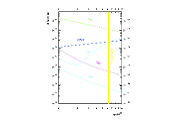High energy astrophysics and early Universe
Formation and evolution of massive black holes
Massive black holes reside at the center of most nearby galaxies. They have masses from less than 100 000 to more than a billion solar masses, and this mass is about 1/1000 of the stellar mass of the host galaxies. Massive black holes are also the central engine that powers quasars and active galactic nuclei, which are the
most energetic stable sources in the Universe. Quasars and active galactic nuclei allow us to trace when and how massive black holes have grown in mass by swallowing gas, and sometimes stars, supplied by the galaxy they live in.
The team develops theoretical models of the formation of massive black hole « seeds » in the first galaxies, of the growth of these seeds over the cosmic history, along with the galaxies hosting them. The dynamics of massive black holes is also studied to
predict their merger rate in the gravitational wave domain. For
these studies, both analytical, semi-analytical models and numerical simulations are used.
Permanent researchers: Jean-Pierre Lasota, Marta Volonteri
Modelling gamma-ray bursts and other astrophysical sources of high-energy radiation
Gamma-ray bursts are extragalactic cosmic explosions which appear to be the brightest in the Universe. Their physical modeling aims to build a coherent description of the emitted radiation during the “prompt” and “remanent” phases. The proposed scenario considers an ultra-relativistic jet produced by a compact source.
The dissipation of a fraction of the jet's kinetic or/and magnetic energy in shocks or via magnetic reconnection is probably responsible for the prompt emission (the burst itself) while the deceleration of the jet by the external medium produces, at lower energy, the afterglow that follows the burst.
In the past years team members have developed a series of models to describe these different phases. In addition, they are strongly involved in the preparation of the Chinese-French SVOM space mission (to be launched in 2021), which will study in details gamma-ray bursts and their remanences and will use them as a tool to study the distant Universe.
Various projects are being developed in the group to study the physics of accretion disks and jets in compact binary systems or active galactic nuclei. The properties of these disks and jets are now within the reach of many instruments (RXTE, Chandra, XMM, ASCA, Fermi …) in various astrophysical sites, which provide crucial constraints for their modelling.
Permanent researchers: Frédéric Daigne, Jean-Pierre Lasota, Robert Mochkovitch
Big-Bang Nucleosynthesis (BBN) and cosmic evolution of baryons
The composition of the baryonic matter evolves due to nuclear process during the Big-Bang, within stars or in the interstellar medium. Regarding primordial nucleosynthesis, team members regularly update models, in close connection with nuclear physics experts. Particular attention is paid to Lithium 7 since for this isotope, decrepancies between measurements and predictions remain.
Models are now sophisticated enough to provide constraints on "new physics" effects, in particular on potential fundamental constants variations. Thus, it was established within the team that time variation of the binding energy of the deuterium nucleus could solve the Li 7 problem.
Moreover, a model has been developped which describes the chemical evolution on large scales in the Universe due to stellar nucleosynthesis, within the standard hierarchical structure formation scenario.
All available observational data have been taken into account (abundances, star formation rate ...). Constraints could be obtained on the allowed mass range for the first stars, as well as on the gravitational waves and neutrinos associated to the corresponding supernovae. This model has been extended in order to describe the scatter of chemical abundances in the distant Universe. Finally, from an analysis of the "3 alpha" carbon 12 formation reaction within population III stars, upper limits have been derived on the time variation of some fundamental constants.
Permanent researchers: Frédéric Daigne, Jo Silk, Jean-Philippe Uzan, Elisabeth Vangioni,
Spectroscopic studies of lines of sight to distant sources : probing intergalactic, circumgalactic and interstellar gas in the distant Universe
The analysis of high resolution quasar spectra is a powerful means to investigate the properties of the intergalactic medium and of gas associated to intervening galaxies in the distant Universe. Using data collected on the largest telescopes (VLT/ESO in particular), team members could study the properties of dense molecular-rich (H2, CO) gas located in the inner regions of remote galaxies and compare them to those of the local interstellar medium. Further, the hot gas revealed by OVI absorption and surrounding
distant galaxies has been investigated; it has been shown that at high redshift, a significant fraction of the baryonic mass is in this phase.
By correlating the spectra of quasars separated by a few arcminutes on the sky, the spatial distribution of the gas could be studied and compared to the predictions of current models. On larger scales, the large BOSS and eBOSS surveys have allowed members of the team to detect baryonic oscillations and observe the decelerated expansion phase, preceding the present accelerated expansion epoch related to dark energy.
Permanent researchers: Jacqueline Bergeron, Patrick Boissé, Pasquier Noterdaeme, Patrick Petitjean
Detection and observations of sources at high redshift
In order to probe the distant Universe, it is necessary to identify and study new bright sources at high redshift. This is done within the team for several types of sources : a) ultra-luminous infrared galaxies discovered by the Herschel space mission, for which we observe the dust, CO and H2O emission using the IRAM telexcopes or ALMA, b) quasars that can be identified through their color or variability in large imaging surveys, c) gamma-ray bursts, for which detailed modelling of their redshift distribution is done, in order to optimize the preparation
of the future space mission SVOM, currently developed at IAP in particular.
Permanent researchers: Jacqueline Bergeron, Frédéric Daigne, Robert Mochkovitch, Alain Omont, Patrick Petitjean


 BBN Nucleosynthesis
BBN Nucleosynthesis

